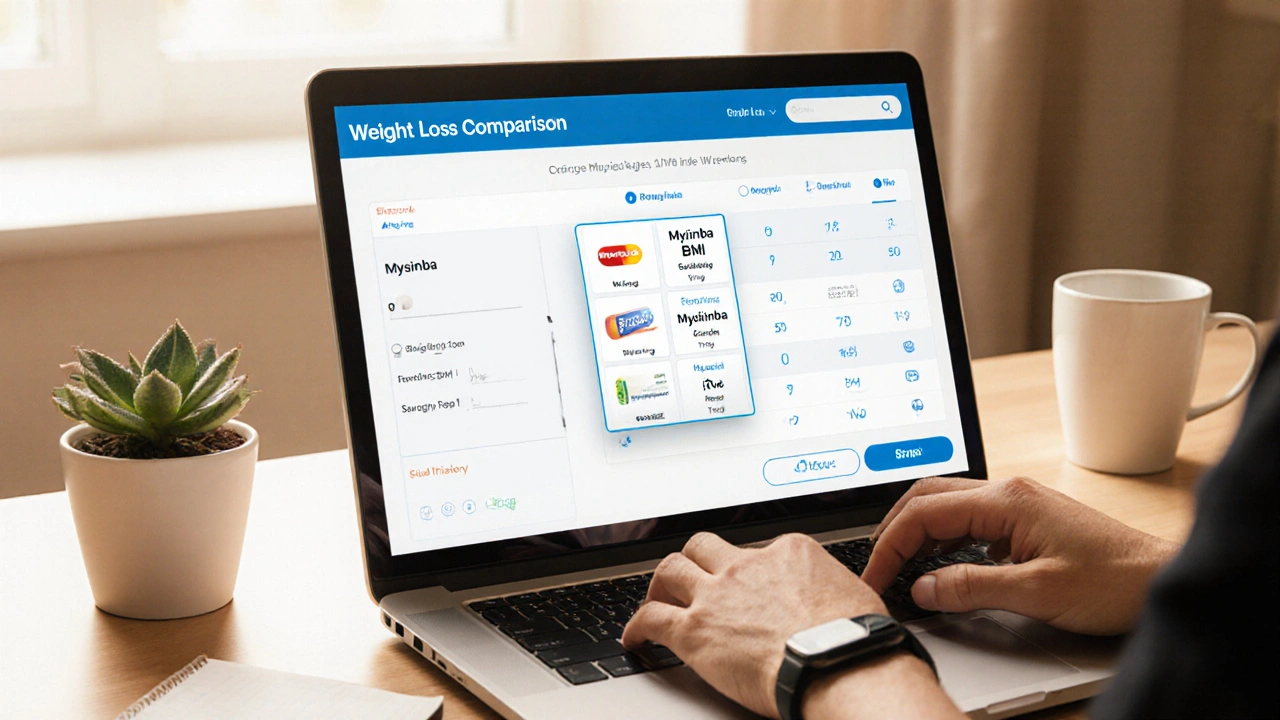Weight Loss Medication Comparison Tool
Medication Details
Mechanism: Naltrexone + Bupropion (opioid antagonism + POMC activation)
Formulation: Oral tablet
FDA Approval Year: 2014
Average Weight Loss: 5-10% over 12 months
Common Side Effects: Nausea Headache Insomnia
Notes: Requires monitoring of blood pressure due to bupropion component.
How It Compares
| Medication | Mechanism | Avg. Weight Loss | Formulation |
|---|---|---|---|
| Mysimba | Naltrexone + Bupropion | 5-10% | Oral tablet |
| Saxenda | GLP-1 receptor agonist | 5-10% | Daily injection |
| Wegovy | GLP-1 receptor agonist (high-dose) | 15% | Weekly injection |
| Qsymia | Phentermine + Topiramate | 5-10% | Oral capsule |
| Phentermine | Sympathomimetic appetite suppressant | 5-10% | Oral tablet |
| Orlistat | Lipase inhibition | 5% | Oral capsule |
Decision Guide
When choosing a weight-loss medication, consider these factors:
- Health conditions: Avoid drugs that may worsen hypertension or seizure risk
- Speed of results: GLP-1 agents typically show greater weight loss
- Administration route: Oral tablets vs. injections
- Cost considerations: Mysimba is often more affordable than injectables
- Side effect tolerance: GI upset vs. mood changes vs. sleep disruption
People considering prescription help for weight management often wonder whether Mysimba is the right choice or if another option would work better.
Key Takeaways
- Mysimba combines naltrexone and bupropion to curb appetite and reduce food cravings.
- Clinical trials show an average 5‑10% body‑weight reduction over a year.
- Alternative drugs differ in mechanism-some mimic gut hormones, others act as stimulants.
- Choosing the best medication depends on health profile, side‑effect tolerance, and insurance coverage.
What Is Mysimba?
Mysimba is a fixed‑dose combination of naltrexone, an opioid antagonist, and bupropion, an antidepressant that also reduces appetite. The product received FDA approval in 2014 for chronic weight management in adults with a BMI of30or higher, or27with weight‑related health issues.
How the Naltrexone‑Bupropion Duo Works
The two ingredients hit separate brain pathways. Naltrexone blocks the mu‑opioid receptors that usually make eating feel rewarding, while bupropion stimulates the pro‑opiomelanocortin (POMC) neurons that signal fullness. Together, they blunt cravings and lower overall calorie intake.
Clinical Effectiveness
Four pivotal PhaseIII trials (COR‑I through COR‑IV) enrolled more than 7,000 participants. Over 56weeks, average weight loss was:
- 5.4% of initial body weight for the Mysimba group
- 2.2% for placebo
Responders-those losing ≥5%-made up roughly 45% of the treatment arm versus 18% on placebo. Long‑term follow‑up (up to 2years) suggests maintenance of most of that loss when lifestyle counseling continues.

Safety Profile and Common Side Effects
The most frequently reported events are nausea, constipation, headache, and insomnia. Because bupropion can raise blood pressure, clinicians monitor systolic values regularly. Contra‑indications include uncontrolled hypertension, seizure disorders, and concurrent use of MAO‑inhibitors.
Other Prescription Weight‑Loss Options
Below are the main FDA‑approved alternatives, each with a distinct mechanism.
Saxenda (liraglutide) is a once‑daily GLP‑1 receptor agonist that mimics a gut hormone to slow gastric emptying and increase satiety.
Wegovy (semaglutide) is a weekly injectable GLP‑1 analogue offering stronger appetite suppression, with clinical trials showing about 15% average weight loss.
Qsymia blends phentermine, a sympathomimetic stimulant, with topiramate, an anticonvulsant that also reduces appetite.
Phentermine on its own is a short‑term appetite suppressant approved for up to 12weeks; it works by releasing norepinephrine.
Orlistat is a lipase inhibitor that blocks about 30% of dietary fat absorption, leading to modest weight loss.
Semaglutide (the oral formulation) provides a non‑injectable GLP‑1 option, though weight‑loss data are still emerging.
Comparison at a Glance
| Drug | Mechanism | Formulation | FDA Approval Year | Avg. Weight Loss % (12mo) | Common Side Effects |
|---|---|---|---|---|---|
| Mysimba | Naltrexone + Bupropion (opioid antagonism + POMC activation) | Oral tablet | 2014 | 5‑10% | Nausea, headache, insomnia |
| Saxenda | GLP‑1 receptor agonist | Daily injection | 2014 | Nausea, vomiting, pancreatitis risk | |
| Wegovy | GLP‑1 receptor agonist (high‑dose) | Weekly injection | 2021 | GI upset, gallbladder disease | |
| Qsymia | Phentermine + Topiramate (stimulant + anticonvulsant) | Oral capsule | 2012 | Tingling, dry mouth, mood changes | |
| Phentermine | Sympathomimetic appetite suppressant | Oral tablet | 1959 | Increased heart rate, insomnia | |
| Orlistat | Lipase inhibition (fat malabsorption) | Oral capsule | 1999 | Steatorrhea, oily spotting |
Making the Right Choice: Decision Criteria
- Health conditions. If you have hypertension or a history of seizures, avoid drugs that raise blood pressure (Mysimba) or lower seizure threshold (Qsymia).
- Desired speed and magnitude of loss. GLP‑1 agents (Wegovy, Saxenda) tend to produce the biggest drops, whereas Orlistat offers modest changes.
- Route of administration. Some patients prefer oral pills (Mysimba, Qsymia, Orlistat) to injections (Wegovy, Saxenda).
- Insurance coverage. Many plans favor older drugs like Orlistat or Phentermine; newer GLP‑1 drugs often need prior authorization.
- Side‑effect tolerance. GI upset is common with GLP‑1 drugs, while mood changes and insomnia appear more with stimulant‑based combos.
Practical Tips for Starting a Prescription Weight‑Loss Program
- Get a baseline BMI and metabolic panel; most drugs require a BMI≥30 or≥27 with comorbidities.
- Schedule a follow‑up at 4‑6 weeks to assess tolerance and adjust dose.
- Combine medication with a structured diet (e.g., Mediterranean) and at least 150minutes of moderate activity per week.
- Monitor blood pressure and heart rate if you’re on Mysimba or Qsymia.
- Keep a side‑effect diary; report persistent nausea or mood swings to your clinician promptly.

Frequently Asked Questions
Can I take Mysimba if I’m already on an antidepressant?
Because bupropion is itself an antidepressant, combining it with another serotonergic agent can increase the risk of seizures. Your doctor should review all meds before adding Mysimba.
How does Mysimba compare to the newer GLP‑1 drugs in terms of cost?
Mysimba is a generic‑type oral tablet, so out‑of‑pocket costs are usually lower than weekly injectables like Wegovy, which can exceed $1,300 per month without insurance assistance.
Is a 5% weight loss clinically meaningful?
Yes. A 5% reduction often improves blood pressure, cholesterol, and blood‑sugar levels enough to lower the risk of type‑2 diabetes and heart disease.
What happens if I stop taking Mysimba abruptly?
Stopping suddenly can lead to rebound appetite, so clinicians usually taper the dose over two weeks while reinforcing diet and exercise habits.
Can I use Mysimba while pregnant or breastfeeding?
Both naltrexone and bupropion are classified as pregnancy category C; they are generally avoided unless the potential benefit outweighs the risk. Discuss alternatives with your OB‑GYN.
Bottom line: If you need an oral option that tackles cravings from two angles, Mysimba remains a solid choice. But if you’re after bigger, faster results and don’t mind injections, a GLP‑1 drug like Wegovy may be worth the extra cost. Always partner with a healthcare professional to match the drug to your health profile and lifestyle.

Samson Tobias
October 3, 2025 AT 20:36If you’re weighing options, keep in mind that Mysimba’s dual mechanism tackles cravings from two angles, which can be a real game‑changer for folks who struggle with emotional eating. It’s taken a while for the data to settle, but the 5‑10% weight loss over a year is consistent across the larger trials. The oral tablet format also means you skip the hassle of injections, a point many patients appreciate. Just be vigilant about blood pressure checks because the bupropion component can nudge numbers upward. Overall, it’s a solid middle‑ground choice between the modest pills and the pricey injectables.
Alan Larkin
October 3, 2025 AT 22:00Honestly, the table already tells you everything you need. 😊
John Chapman
October 3, 2025 AT 23:23One must acknowledge that the pharmacological elegance of Mysimba resides in its synergistic antagonism of opioid receptors coupled with POMC activation, a nuance often glossed over by lay discussions. While the average 5‑10% reduction may appear modest, it represents a statistically significant shift when contextualized against the baseline metabolic set‑point. Moreover, the oral administration circumvents the psychosocial barriers associated with subcutaneous delivery platforms such as Wegovy. The scholarly consensus underscores the necessity of concurrent lifestyle interventions to sustain this pharmacotherapy’s efficacy. In contrast, agents like Orlistat, though mechanistically distinct, often falter due to adherence challenges imposed by gastrointestinal side effects.
Tiarna Mitchell-Heath
October 4, 2025 AT 00:46Stop acting like you’ve never heard of GLP‑1 drugs!
Katie Jenkins
October 4, 2025 AT 02:10Mysimba’s place in the therapeutic arsenal is often misunderstood, so let’s break it down piece by piece. First, the combination of naltrexone and bupropion targets two separate neurochemical pathways: the reward circuitry and the satiety signals. This dual action means that patients may experience a reduction in cravings that goes beyond simple appetite suppression. Second, the clinical trials consistently show a 5‑10% weight loss over 12 months, which, while not as dramatic as the 15% seen with high‑dose GLP‑1 analogues, is still meaningful for metabolic health. Third, the oral tablet format eliminates the needle anxiety that many patients have with drugs like Wegovy and Saxenda. Fourth, the side‑effect profile of Mysimba is generally tolerable; nausea, headache, and insomnia are the most common, and they often diminish after the initial titration period. Fifth, because bupropion can raise blood pressure, regular monitoring is essential, especially for patients with pre‑existing hypertension. Sixth, the drug is contraindicated in individuals with seizure disorders, so a thorough medical history is a prerequisite. Seventh, cost considerations often favor Mysimba over injectable GLP‑1 agents, which can be prohibitively expensive without insurance assistance. Eighth, adherence rates tend to be higher with oral medications, translating to better long‑term outcomes. Ninth, combining Mysimba with a structured diet and exercise program amplifies the benefits, as seen in the COR‑IV trial where lifestyle counseling was a core component. Tenth, real‑world data suggest that responders-those losing at least 5% of body weight-experience improvements in blood pressure, lipid profiles, and glycemic control. Eleventh, the drug’s mechanism does not rely on gastrointestinal motility, so patients who cannot tolerate the GI side effects of GLP‑1 agonists may find Mysimba more acceptable. Twelfth, the FDA approval in 2014 was based on robust Phase III data, reinforcing its safety and efficacy. Thirteenth, the medication is taken twice daily, which may be seen as a minor inconvenience but also allows for flexible dosing adjustments. Fourteenth, the drug’s impact on mood is generally neutral, though some patients report mild insomnia, which can be managed with timing adjustments. Fifteenth, in the broader context of weight‑management strategies, Mysimba offers a balanced trade‑off between efficacy, safety, convenience, and cost.
Jack Marsh
October 4, 2025 AT 03:33While many tout the “miracle” of GLP‑1 injections, the modest yet steady results from Mysimba should not be dismissed as merely “average.”
Terry Lim
October 4, 2025 AT 04:56Bottom line: if you can’t handle the blood‑pressure monitoring, skip Mysimba.
Cayla Orahood
October 4, 2025 AT 06:20Honestly, the drama around “new” weight‑loss drugs makes me wonder if people are just looking for a quick fix rather than a sustainable lifestyle change.
McKenna Baldock
October 4, 2025 AT 07:43From a philosophical standpoint, the choice of medication reflects a deeper negotiation between bodily autonomy and medical authority; each pill or injection is a covenant we make with our future selves.
Roger Wing
October 4, 2025 AT 09:06i get the point about cost but the side effects are real and i think people need to read the fine print more often
Matt Cress
October 4, 2025 AT 10:30Oh great, another “miracle” pill-because what the world really needed was more pharma hype. 🙄
Andy Williams
October 4, 2025 AT 11:53The data are clear; Mysimba offers a modest benefit without the injection inconvenience.
Paige Crippen
October 4, 2025 AT 13:16It’s just another drug; nothing special.
sweta siddu
October 4, 2025 AT 14:40Hey everyone! 🌟 If you’re curious about the oral option, Mysimba can be a good fit if you prefer pills over shots. Feel free to share your experiences! 😊
Ted Mann
October 4, 2025 AT 16:03Interesting take, Sweta-just remember that every medication has hidden trade‑offs, and the “pill vs. injection” debate often masks the real issue of long‑term adherence.
Brennan Loveless
October 4, 2025 AT 17:26We should prioritize American‑made treatments like Mysimba over foreign alternatives-it’s about national health sovereignty.
Vani Prasanth
October 4, 2025 AT 18:50Supporting anyone who chooses a path that aligns with their health goals, whether that’s Mysimba or a GLP‑1 agonist. You’ve got this!
Maggie Hewitt
October 4, 2025 AT 20:13Sure, because spending a small fortune on injections is totally the solution to all our problems. 🙃